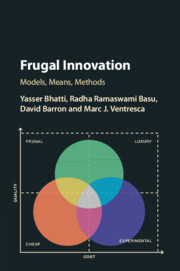Book contents
- Frugal Innovation
- Reviews
- Frugal Innovation
- Copyright page
- Dedication
- Epigraph
- Contents
- Figures
- Tables
- Foreword
- Preface
- Acknowledgements
- Abbreviations
- Introduction
- Part I Models of Frugal Innovation
- Part II Towards a Theory of Frugal Innovation
- Conclusion
- Part III Tools for Practice and Research
- Appendices
- References
- Bibliography
- Index
- References
References
Published online by Cambridge University Press: 30 October 2018
- Frugal Innovation
- Reviews
- Frugal Innovation
- Copyright page
- Dedication
- Epigraph
- Contents
- Figures
- Tables
- Foreword
- Preface
- Acknowledgements
- Abbreviations
- Introduction
- Part I Models of Frugal Innovation
- Part II Towards a Theory of Frugal Innovation
- Conclusion
- Part III Tools for Practice and Research
- Appendices
- References
- Bibliography
- Index
- References
- Type
- Chapter
- Information
- Frugal InnovationModels, Means, Methods, pp. 262 - 297Publisher: Cambridge University PressPrint publication year: 2018



